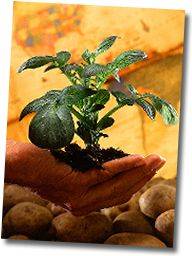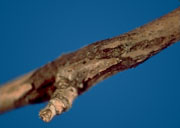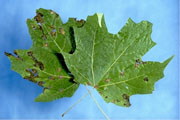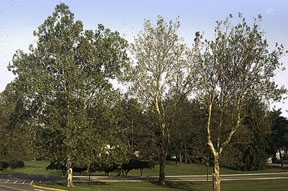|



| |
Anthracnose is a name for a group of diseases caused by several closely
related fungi that attack many of our finest shade trees. It occurs most
commonly and severely on sycamore, white oak, elm, dogwood, and maple. Other
host plants that are usually only slightly affected include linden (basswood),
tulip tree, hickory, birch, and walnut. Each species of anthracnose fungus
attacks only a limited number of tree species. The fungus that causes sycamore
anthracnose, for example, infects only sycamore and not other tree species.
Other anthracnose-causing fungi have similar life cycles, but require slightly
different moisture and temperature conditions for infection.
Symptoms

Fig. 1. Blighting of leaf tissue caused by
the sycamore anthracnose fungus.
(Photo by E. Dutky-U. Md.)
.
Fig. 2. Twig canker caused by the sycamore
anthracnose fungus.
(Photo by E. Dutky-U. Md.).

Fig. 3. Leaf symptoms of anthracnose on
sugar maple.
(Photo by M. A. Hansen)
Fig. 4. Anthracnose on ash.
(Photo by Virginia Tech Photo Lab
Anthracnose fungi may cause defoliation of most maple, oak, elm, walnut,
birch, sycamore, and hickory species and, occasionally, of ash and linden trees.
Damage of this type usually occurs after unusually cool, wet weather during bud
break. Single attacks are seldom harmful to the tree, but yearly infections will
cause reduced growth and may predispose the tree to other stresses. Damage may
be in the form of:
 |
killing of buds, which stimulates the development of many short twigs or
"witches' brooms;" these may spoil the shape of the tree
|
 |
girdling and killing of small twigs, leaves, and branches up to an inch in
diameter |
 |
repeated early loss of leaves, which over several successive years weakens
the tree and predisposes it to borer attack and winter injury |
 |
premature leaf drop, which lessens the shade and ornamental value of the
tree |
Specific symptoms of anthracnose vary somewhat depending on the tree species
infected:
 |
On sycamore, leaves and growing tips of the twigs may die as they
emerge from the bud. This damage is often confused with late frost injury.
Sudden browning and killing of single leaves or leaf clusters may occur as the
leaves expand. The disease continues to develop later in the season, resulting
in irregular brown to nearly black, dead areas between or along the main leaf
veins and extending to the margin (Fig. 1). Infected leaves fall when the
petiole is girdled or when several lesions enlarge and coalesce to form large,
dead blotches. After defoliation from spring infections, the tree may appear
bare except for tufts of leaves at branch tips. Regrowth appears by midsummer.
Sunken cankers form on larger twigs during cooler weather in fall, winter, and
spring (Fig. 2). Twigs may die as a result of canker formation. When terminal
twigs are killed, lateral twigs take over as leaders. Thus, repeated twig
dieback results in the formation of crooked branches. |
 |
On oak, small scattered brown spots or large light brown blotches
form along veins. The leaves look scorched. |
 |
On maple, purplish brown areas form along the veins or larger,
irregular, light to dark brown spots form along or between veins (Fig.3),
extending to the leaf margin. |
 |
On ash, large, irregular, light brown spots appear, most often
along leaf margins (Fig. 4). |
 |
On linden, large brown areas with black margins appear, especially
along main leaf veins. The areas are small to large and circular to elongate.
|
 |
On birch, small, irregular, circular, brown spots with dark brown
margins are apparent. |
 |
On hickory, large, irregular, reddish brown spots appear on the
upper leaf surface and a dull brown area is apparent on the lower leaf
surface. |
 |
On walnut, irregular, circular, dark brown to black spots are
visible on leaves. |
 |
On dogwood, two different anthracnose diseases may occur. Symptoms
of spot anthracnose include tiny leaf and bract spots, about the size
of a pinhead, with whitish centers and purplish borders. Symptoms of
Discula anthracnose (dogwood anthracnose) include irregular, small to
large brown blotches with purplish borders on leaves and bracts, lower branch
dieback, and trunk cankers that culminate in death of the tree. |
Disease Cycle
Anthracnose fungi overwinter in infected leaves on the ground. Some
canker-causing anthracnose fungi, such as the sycamore anthracnose fungus, also
overwinter in twigs on the ground or in cankered twigs that remain on the tree.
Microscopic spores of most anthracnose fungi are produced in infected tissues
during April and May. The spores are blown and splashed to the buds and young
leaves and, with favorable moisture conditions, penetrate and infect the
swelling buds and unfolding leaves. Long rainy periods help the fungus to spread
rapidly.
Control
Disease control measures for different trees vary slightly because the period
of infection is different depending on the fungal species involved. If
fungicides are used, sprays must be applied on a preventative basis, beginning
before infection takes place. Spraying large trees for many anthracnose diseases
may be impractical and unnecessary, especially in dry springs. Sanitation is
important in reducing the amount of fungal inoculum available for new
infections. For large, high-value sycamore trees, injection with the fungicide,
thiabendazole hypophosphite (e.g. Arbotect 20-S), on a 3-year basis is also an
option (Fig 5).
|

Fig. 5. Two trees on right showing symptoms of sycamore anthracnose compared
to tree injected with Arbotect 20-S fungicide on left.
(Photo by R. J. Stipes) |
For effective anthracnose control of most anthracnose diseases:
 |
Rake up and remove infected leaves in the fall. Leaves may be shredded and
composted or burned. |
 |
Prune out and burn or bury dead twigs and small branches. Prune to thin
the crown. Thinning will improve air movement and promote faster drying of the
leaves. |
 |
If fertilizer is needed, fertilize in the fall about a month after the
average date of the first frost or in early spring about a month before the
date of the last frost to increase tree vigor. |
 |
If chemical control is desired, spray with a fungicide containing mancozeb
(e.g. Manzate 200, Dithane M-45) at budswell and twice again during leaf
expansion (in most years, this would be at 10-14 day intervals). Follow label
rates or refer to the current Virginia Pest Management Guide for Home Grounds
and Animals (VCE Publication 456-018), http://www.ext.vt.edu/pubs/pmg/,
for details on fungicide application. For information on the proper use of
pesticides and fungicides, refer to any current VCE pest management guide.
|
 |
Because Discula anthracnose is often fatal to the tree, control of this
anthracnose disease on dogwood is a special case and is described in VCE
Publication 450-611W, Foliar Diseases of Dogwood. |
Authors: R. J. Stipes, Professor of Plant Pathology,
Department of Plant Pathology, Physiology and Weed Science, Virginia Tech; and
Mary Ann Hansen, Extension Plant Pathologist, Department of Plant Pathology,
Physiology and Weed Science, Virginia Tech
|
![]() Gardeners' Corner
Kids'
Garden
Sustainable Garden
Contact Us
Gardeners' Corner
Kids'
Garden
Sustainable Garden
Contact Us![]()





